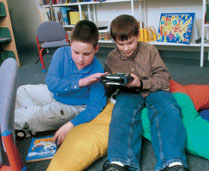The following is a press release from the federal Institute of Museum and Library Services (IMLS). Having trouble viewing this e-mail? Read it online at http://www.imls.gov/profiles/Jul11.shtm.
FOR IMMEDIATE RELEASE IMLS Press Contacts July 2011 Project Profile: State Talking Book Libraries: Programs for People with Visual or Physical Disabilities
Talking books are wonderful and make my life so much better. It is such a blessing to have talking books. Multiple sclerosis has taken a great deal of my vision. IMLS provides funding to state libraries through its Grants to State Library Administrative Agencies, the largest of all of its grant programs. In 2009, 10% of this funding directly supported libraries for the blind and physically disabled. State libraries around the country provide critical services to visually and physically impaired Americans including braille materials and specially recorded audiobooks also known as "talking books". Materials are mailed to patrons at no cost and provide an important lifeline to the world for many housebound or elderly patrons. For two of these libraries—the Kentucky Talking Book Library (KTBL) and the Washington Talking Book & Braille Library (WTBBL)—success has continued, despite recent budget cutbacks, thanks to dedication from volunteers, strong connections with community groups and patrons, and the enthusiastic adoption of new technology. “I think a lot of people believe, ‘There are lots of audiobooks and ebooks out there, [those who are visually and physically impaired] don't need anything special.’ But I don't think people realize the very small percentage of materials that are available in alternate formats," said Barbara Penegor, Kentucky Talking Book Library Branch Manager. “If you go into your local public library, sure they have audiobooks on CD ... but they don't have the number of books available through our service, or they don't have the breadth of service. Most of them will have the bestsellers or popular things, but we're able to provide them with stuff like cookbooks and books on disability and biographies of lesser–known historical figures.” Click on image to access video (YouTube) New Technology Increases Access and Enhances User Experiences In Washington, word of mouth about the new technology helped spur renewed interest in the library says Danielle Miller, Program Manager for WTBBL. “People were getting [digital players] who hadn't used the library in forever. People were signing up who had never used the library. Books were going out pretty much as soon as they came in the door and people were willing to read things that they never would have read before because they wanted to use the digital player.” Volunteer Support Ensures Program Success Volunteers read local and national newspaper articles, host talk shows about local events, and conduct interviews with popular authors. The programming is more than just entertainment, however. It also provides practical information that would otherwise be difficult for the visually impaired to access. “One of our most popular programs is called “Grocery Cart”, explains Miller. “All the supermarket circulars come out on Tuesdays and the volunteer narrators go through and read what's for sale and where it's for sale. It's a nice way for a lot of our people who maybe get out only once a week or are on a fixed income. They can see, ‘Oh cantaloupe is on sale at Safeway. Let's go there.’” KTBL relies heavily on volunteer support as well, particularly for the narration and recording of their special collection of books about Kentucky or by Kentucky authors. KTBL has had a wonderful record of volunteer loyalty—many of their volunteers have been with the library for 20 years or more. Penegor works hard to give back to the volunteers, arranging trips to see how braille books are printed and inviting special speakers to the yearly volunteer appreciation dinner. “This year we're hoping to have some professional narrators—people who are paid to record the talking books from the Library of Congress—come in and talk to them so they can meet a superstar!” Using Communications, Outreach, and Partners to Respond to Fiscal Challenges In the past few years, KTBL has taken over library services for regional talking book libraries which were forced to close their doors. Good communication between the branches allowed for a smooth transition and minimal disruption to patrons. “Even though the Louisville library closed three years ago I'm still in occasional contact with the former librarian,” says Penegor. In Washington, other public libraries and patrons have stepped in to help replace services the WTBBL can no longer afford. “Some of our large print readers know that we can't afford to buy these books any more so they often donate books that they have read or money specifically for that purchase,” says Miller. “We've been working with public libraries in the area and getting donations. Recently, a public library system donated 14 boxes of large print books in great condition.” Improving Quality of Life for Patrons IMLS remains committed to making accessibility and inclusion top priorities for the agency and the libraries and museums it serves. Learn more at http://www.imls.gov/about/accessibility.shtm. Click here to find Talking Book Library services in your community. About the Institute of Museum and Library Services |


